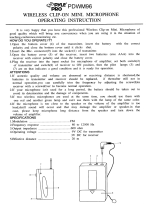
Focus on the spoken word
15
Future-proof, license-free audio transmission
SpeechLine Digital Wireless operates in the future-proof 1.9 GHz frequen-
cy band. Transmission in this band is not affected by regulatory changes of
the digital dividend or by the auctioning of frequencies. In addition, the fre-
quencies in this band can be used without a license. With SpeechLine Dig-
ital Wireless, you don't have to fear changes to the frequency band used
which could possibly mean having to buy new audio equipment. The acqui-
sition of a SpeechLine Digital Wireless system is a future-proof invest-
ment.
To allow optimum use of the 1.9 GHz frequency band, SpeechLine Digital
Wireless offers two operating modes: For up to 20* links used in parallel,
the Adaptive Power Mode ensures extremely easy startup and a reliable
maximum range. The Multi-Room Mode allows you to adjust the transmis-
sion power to allow for a considerably larger number of links. These adjust-
ment options make SpeechLine Digital Wireless the optimum solution for
a great variety of projects with widely differing installation sizes at the
same location.
* depending on the locally approved variant
Tap-proof audio transmission
The encrypted, tap-proof transmission of information is especially import-
ant in the corporate environment. This is why we decided to use 265-bit
AES encryption when developing the SpeechLine Digital Wireless series.
Here the security of wireless transmission is ensured by the generation of
a new key each time a new connection is made between transmitter and
receiver. At every meeting and every conference, this guarantees that only
the receiver paired with the transmitter is able to decode the audio signal.
Encryption cannot be deactivated – making SpeechLine Digital Wireless
secure at all times.
Extremely long battery life
It is not necessary to replace or recharge the accupack during operation.
The battery life is about 15 hours – enough for even a very long conference
day. Intelligent energy management using adaptive transmission power
maximizes the battery life.
To charge the accupacks, it is not necessary to remove them from the
transmitters. They can be recharged using the optional CHG 2 charger for
handheld and pocket transmitters or directly via the supplied USB charging
cable.
Easy control using the Sennheiser Control Cockpit software
Sennheiser Control Cockpit is the central software for easy handling, con-
trol and maintenance of the entire SpeechLine Digital Wireless system.
The easy-to-use Sennheiser Control Cockpit software provides a global
overview of all network enabled SpeechLine Digital Wireless devices at all
times. It shows all status information at a glance and makes setting adjust-
ments for one or multiple devices at the same time very easy. The room
overview connects the locations of all components to their respective sta-
tus information, so the user always knows the location and status of a spe-
cific device. The Sennheiser Control Cockpit is accessible everywhere in
the intranet via a web browser across all platforms. As a result, the soft-
ware allows you to manage even huge setups with hundreds of devices
with minimal effort.





















